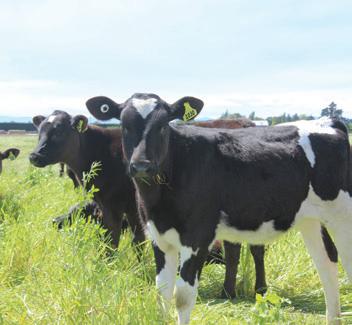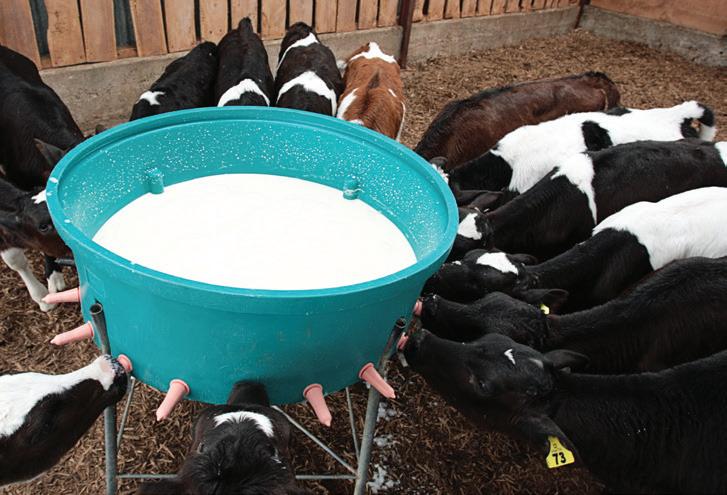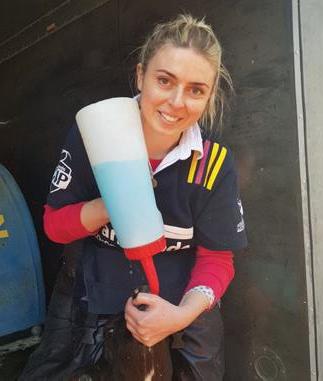
3 minute read
Monitoring growth around weaning
If a calf’s rumen has been well developed and they have had adequate hard feed intake, a post-weaning check will be less pronounced as the calf will have an increased ability to digest grass.
The post-weaning growth check found in many calves is due to three factors: • Low intakes of dry feed up until weaning will result in limited rumen development. This will result in a significant growth check while the rumen becomes accustomed to digesting significant quantities of dry feeds. • High intakes of bulky roughage such as hay pre-weaning. Calves are physically unable to eat enough roughage to sustain rapid growth weights with a small developing rumen. • Calves stress when feeds are changed.
Continuing to feed familiar hard feed post-weaning will minimise problems.
Top tips for minimising the post-weaning growth check
• Ensure calves are eating a minimum of 1 - 1.5kg (depending on the calf breed) of hard feed for at least 3 consecutive days before they are weaned. This will ensure their rumen is developed enough to handle the change to fermenting larger quantities of grass. • Continue to feed hard feed in the paddock – this will help to support the calf as they go through the weaning process and will ensure they still consume adequate energy and protein.
Some calf rearers choose to continue to offer hard feed past the weaning period.
The extra energy and added bypass protein helps to support calf growth. • Do not wean calves during periods of additional stress, e.g. bacterial infection, dehorning, exceptionally hot or cold weather. • Wean via a graduated method where calves are gradually offered lower amounts of milk, this is the preferred method. Abrupt weaning can be a challenge for calves and create unnecessary stress. • Keep an eye on calves, continue to monitor weight and offer more hard feed if periods of poor pasture quality or pasture deficit arise, to ensure they continue to reach growth targets. Daily visual checks need to continue particularly around time of stress e.g. bad weather.
Continuing growth post-weaning to mating
Calves that have been grown well up to weaning can slip behind growth targets during their first summer, autumn and winter if pasture supply is limited or pasture quality declines. Falling behind on growth targets can have an impact on the fertility of a calf when it comes to their first mating, as one of the main triggers of puberty is body weight rather than the age of an animal. If a calf does manage to get pregnant but is still struggling to reach growth targets, this can have a significant impact on the production in their first lactation as they will still have growth to catch up on post-calving and milk production will be sacrificed in order for the animal to continue growing. Well grown animals with good muscle and skeletal growth will also be able to compete with older animals in the herd, whereas smaller, under-grown heifers may be bullied and miss out on their fair share of feed. Summer can be a period of pasture deficit, as dry periods or excessive heat can limit pasture growth and encourage reproductive growth and reduced feed quality. Autumn can be a period of higher pasture growth but the pasture can often be lacking in sugar due to decreased sunlight, which can slow down rumen fermentation. Winter can be a tough time for calves, particularly if weather conditions are poor. In all of these situations calves may be struggling to meet growth targets, going through periods of below target growth rates or even weight loss followed by periods of catch-up growth if pasture quality allows. This is an inefficient way to grow a calf and it is better to grow them consistently and to support lean muscle and frame growth and avoid fat deposition. One way to ensure you continue to meet growth targets regardless of pasture quality or quantity and weather events, is to offer calves hard feed post-weaning through to mating when necessary — particularly if you notice that the calves are not putting on the weight that they need to. Feeding a pelleted feed during periods of poor pasture growth or quality will ensure that calves still reach growth targets and are well set up for a productive life. If calves cannot be weighed, height can be correlated to liveweight and provide a useful indication of how calves are doing.









